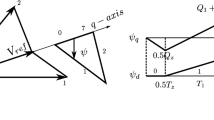Abstract
A novel pulse width modulation (PWM) overmodulation technique based on splitting variable modulating waveform is proposed in this paper. It aims to solve the disadvantages of complex and difficult application of the existing space vector pulse width modulation (SVPWM) overmodulation algorithm and offer a simpler implementation for overmodulation than classic SVPWM techniques. When the modulation index M is within the linear modulation range [0, 1], the modulating waveform is a sinusoidal wave. With the M is increasing within [1, 4/π], the modulating waveform area expands continuously until it becomes a square wave. The PWM output voltage of the vector control system is implemented by using triangle carrier-based sampling pulse width modulation. Furthermore, digital low-pass filters are used in the d-axis current and q-axis voltage of the system, in order to eliminate the negative influence of the PWM low-order harmonics on the proportion integration control in the overmodulation range. The control software is modified and improved to overcome the shortage of slow response speed. The basic logic of the software is to close the filtering process once the load or speed instructions changes and turn on the filtering process when the transient process ends. The contradiction between the filtering and dynamic responses is thus eliminated by using the basic logic. Compared with the SVPWM working in linear region, the constant torque speed regulating range of the AC motor has an improvement of 10% based on the proposed technique. Simulated and experimental results indicate the good effectiveness and feasibility of this technique.















Similar content being viewed by others
References
Nandhini E, Sivaprakasam A (2020) A review of various control strategies based on space vector pulse width modulation for the voltage source inverter. IETE J Res 2:1–15
Pramanick S, Kaarthik RS, Gopakumar K, Blaabjerg F et al (2016) Extending the linear modulation range to the full base speed using a single dc-link multilevel inverter with capacitor-fed h-bridges for im drives. IEEE Trans Power Electron 32(7):5450–5458
Sahoo SK, Bhattacharya T (2015) Field weakening strategy for a vector-controlled induction motor drive near the six-step mode of operation. IEEE Trans Power Electron 31(4):3043–3051
Bolognani S, Zigliotto M (1997) Novel digital continuous control of SVM inverters in the overmodulation range. IEEE Trans Ind Appl 33(2):525–530
Chai M, Xiao D, Dutta R, Fletcher JE (2015) Space vector pwm techniques for three-to-fivephase indirect matrix converter in the overmodulation region. IEEE Trans Ind Electron 63(1):550–561
Giri SK et al (2017) An improved PWM scheme for three-level inverter extending operation into overmodulation region with neutral point voltage balancing for full power factor range. IEEE J Emerg Sel Top Power Electron 6:1527–1539
Stumpf P, Halasz S (2018) Optimization of pwm for overmodulation region of two-level inverters. IEEE Trans Ind Electron 54(4):3393–3404
Guzinski J, Abu-Rub H (2012) Speed sensorless induction motor drive with predictive current controller. IEEE Trans Ind Electron 60(2):699–709
Shi X, Zhu J, Li L, Lu DD-C (2020) Low-complexity dual-vector-based predictive control of th ree-phase pwm rectifiers without duty-cycle optimization. IEEE Access 8:77049–77059
Lee D-C, Lee G-M (1998) A novel overmodulation technique for space-vector pwm inverters. IEEE Trans Power Electron 13(6):1144–1151
Bharatiraja C, Jeevananthan S, Munda JL (2017) A timing correction algorithm-based extended svm for three-level neutral-point-clamped mli in over modulation zone. IEEE J Emerg Sel Top Power Electron 6(1):233–245
Priestley M, Fletcher JE, Tan C (2018) Space-vector pwm technique for five-phase openend winding pmsm drive operating in the overmodulation region. IEEE Trans Ind Electron 65(9):6816–6827
Lee H, Hong S, Choi J, Nam K, Kim J (2018) Sector-based analytic overmodulation method. IEEE Trans Ind Electron 66(10):7624–7632
Beig AR (2012) Synchronized svpwm algorithm for the overmodulation region of a low switching frequency medium-voltage three-level vsi. IEEE Trans Ind Electron 59(12):4545–4554
Gupta AK, Khambadkone AM (2007) A general space vector pwm algorithm for multilevel inverters, including operation in overmodulation range. IEEE Trans Power Electron 22(2):517–526
Zhou K, Wang D (2002) Relationship between space-vector modulation and three-phase carrier based pwm: a comprehensive analysis [three-phase inverters]. IEEE Trans Ind Electron 49(1):186–196
Wang R, Zhao J, Liu Y (2011) A comprehensive investigation of four-switch three-phase voltage source inverter based on double Fourier integral analysis. IEEE Trans Power Electron 26(10):2774–2787
Wang RS (2017) A novel pwm overmodulation technique based on the splitting variable modulating waveform and harmonic influence analysis (in chinese). Trans China Electrotech Soc 32(10):206–213
Chen W, Sun H, Gu X, Xia C (2016) Synchronized space-vector pwm for three-level vsi with lower harmonic distortion and switching frequency. IEEE Trans Power Electron 31(9):6428–6441
Zhou C, Yang G, Su J (2015) Pwm strategy with minimum harmonic distortion for dual three-phase permanent-magnet synchronous motor drives operating in the overmodulation region. IEEE Trans Power Electron 31(2):1367–1380
Acknowledgements
This work was supported by the Natural Science Foundation Program of Fujian Province (2020J01429, 2019J01845), by the Special Research Funded Foundation of Ningde Normal University (2019ZX402), and Talent Introduction Foundation of Ningde Normal University (2022Y17).
Author information
Authors and Affiliations
Corresponding author
Additional information
Publisher's Note
Springer Nature remains neutral with regard to jurisdictional claims in published maps and institutional affiliations.
Rights and permissions
About this article
Cite this article
Wu, B., Wang, R. & Wang, H. Vector control based on splitting variable modulating waveform PWM overmodulation strategy. Electr Eng 104, 3477–3485 (2022). https://doi.org/10.1007/s00202-022-01561-0
Received:
Accepted:
Published:
Issue Date:
DOI: https://doi.org/10.1007/s00202-022-01561-0




